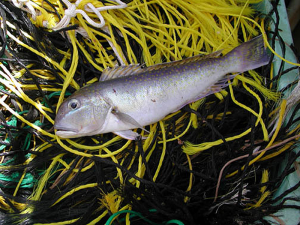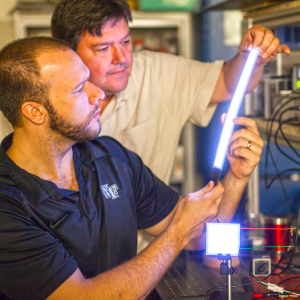Open Access
The Beat
Erin E. Dooley
Erin E. Dooley, MA, is a staff writer for EHP.
A New Lighting Alternative?
Wake Forest University engineers are using multiwalled carbon nanotubes to enhance the brightness of field-induced polymer electroluminescent technology, potentially offering a step forward in the search for safe, pleasing, high-efficiency lighting.1 In this technology, moldable polymer matrix emits light when exposed to an electrical current. It could eventually yield high-efficiency lights without the mercury vapor of compact fluorescent lamps or the bluish tint of some fluorescents and LEDs, which has been linked with circadian rhythm disruption.2
Ceramic Cookstoves May Not Improve Child Pneumonia Rates
Pneumonia is the leading cause of death among children under age 5 in developing countries. Exposure to smoke from fires for cooking and heating is a major risk factor for pneumonia, and cleaner-burning cookstoves are being explored as an intervention. But a new study of locally produced ceramic cookstoves (upesi jikos) in Kenya suggests that “cleaner” isn’t always clean enough when it comes to cookstoves.3 Although upesi jikos were linked with fewer respiratory symptoms, there was no appreciable reduction in pneumonia among babies in households using the stoves compared with babies from households that cooked with traditional three-stone firepits. The authors conclude there is an urgent need for “further research into cookstove design, improved methodology for measuring PM2.5 exposures, and adequately-powered health impact trials.”

The EPA has mandated more targeted testing for fecal contamination of drinking water sources.
Shutterstock
EPA Revises Total Coliform Rule
Coliform bacteria in water are a marker for fecal contamination, which can cause gastroenteritis. This unpleasant but generally nonserious illness can lead to further health problems in vulnerable populations. But not all coliforms are fecal coliforms, so in December 2012 the U.S. EPA revised its Total Coliform Rule for drinking water to establish a maximum contaminant level specifically for Escherichia coli.4 With this more targeted test for fecal contamination, the public must be notified anytime drinking water is found to exceed this level. Noncompliant water systems also must conduct an inspection to locate and correct sources of fecal contamination.
Sound Alerts for Quiet Vehicles
The National Highway Traffic Safety Administration has proposed new rules for “alert sounds” that, when added to quiet electric and hybrid vehicles, will warn pedestrians and cyclists of their presence.5 The proposed rules address concerns that such alerts would increase community noise pollution6 with specifications designed to minimize noise impact while providing ample warning. Under the proposed rules, vehicles must be audible under a wide range of usual street and urban noises when the vehicle is moving slower than 18 mph. The agency estimates that adding alerts will prevent 2,800 pedestrian and cyclist injuries over the life of the 2016 model year fleet.5

Some New York shoppers were sold tilefish, which can be high in mercury, instead of the safer species they thought they were buying.
NOAA
NYC Fish Is Often Mislabeled
In its latest study on the occurrence of mislabeled fish in stores and restaurants, the nonprofit Oceana found that more than a third of the fish sampled in New York City had been mislabeled.7 Tilefish, which is not recommended for small children or pregnant or nursing women because of its high mercury content, was sold as both halibut and red snapper at one grocery store, and 94% of samples of “white tuna” from New York sushi restaurants was actually escolar, which can cause explosive diarrhea due to its high content of wax esters. In all, 58% of the restaurants and stores sampled sold mislabeled fish.
References
1. Chen Y, et al. Effect of multi-walled carbon nanotubes on electron injection and charge generation in AC field-induced polymer electroluminescence. Organ Electr 14(1):8–18 (2013); http://dx.doi.org/10.1016/j.orgel.2012.10.017.
2. Holzman DC. What’s in a color? The unique human health effects of blue light. Environ Health Perspect 118(1):A22–A27 (2010); http://www.ncbi.nlm.nih.gov/pmc/articles/PMC2831986/.
3. Foote EM. Impact of locally-produced, ceramic cookstoves on respiratory disease in children in rural western Kenya. Am J Trop Med Hyg 88(1):132–137 (2012); http://dx.doi.org/10.4269/ajtmh.2012.12-0496.
4. EPA. National Primary Drinking Water Regulations: Revisions to the Total Coliform Rule. 40 CFR Parts 141 and 142. EPA-HQ-OW-2008-0878. Washington, DC:U.S. Environmental Protection Agency (2012). Available: http://water.epa.gov/lawsregs/rulesregs/sdwa/tcr/upload/tcrfinalprepub2012.pdf [accessed 14 Jan 2013].
5. NHTSA. Minimum Sound Requirements for Hybrid and Electric Vehicles. 49 CFR Part 571. NHTSA-2011-0148. Washington, DC:National Highway Traffic Safety Administration, U.S. Department of Transportation (2013). Available: http://www.nhtsa.gov/staticfiles/rulemaking/pdf/Quiet_Vehicles_NPRM.pdf [accessed 14 Jan 2013].
6. Holzman DC. Vehicle motion alarms: necessity, noise pollution, or both? Environ Health Perspect 119(1):A30–A33 (2011); http://www.ncbi.nlm.nih.gov/pmc/articles/PMC3018517/.
7. Warner K, et al. Widespread Seafood Fraud Found in New York City. Washington, DC:Oceana (Dec 2012). Available: http://oceana.org/sites/default/files/reports/Oceana_NYC_Seafood_Fraud_Report_FINAL.pdf [accessed 14 Jan 2012].
Attached Files
Recent Advance Publications
- Association of Osteoarthritis with Perfluorooctanoate and Perfluorooctane Sulfonate in NHANES 2003–2008
- Managing the Health Effects of Temperature in Response to Climate Change: Challenges Ahead
- ONE Nano: NIEHS’s Strategic Initiative on the Health and Safety Effects of Engineered Nanomaterials
- Maternal Exposure to Particulate Air Pollution and Term Birth Weight: A Multi-Country Evaluation of Effect and Heterogeneity
- Performance in Omics Analyses of Blood Samples in Long-Term Storage: Opportunities for the Exploitation of Existing Biobanks in Environmental Health Research
- Arsenic Exposure from Drinking Water and QT-Interval Prolongation: Results from the Health Effects of Arsenic Longitudinal Study
- Endocrine-Disrupting Chemicals (EDCs): In Vitro Mechanism of Estrogenic Activation and Differential Effects on ER Target Genes


0 comments